| |
"May we always have enough taste, sensitivity, and intuition to admit that this talent is large and beautiful. If the brotherhood of critics finds it expedient to look for arguments against this film, which is a witness and a testimony to art and nothing else, we will have to watch the grotesque spectacle of the Lilliputians attacking Gulliver." |
| |
Francois Truffaut, Arts Magazine, 1958
(reprinted in the excellent accompanying booklet) |
And then there are those movies that you don't feel compelled to review as much as provide a greased pathway to let new audiences slip into its extraordinary pleasures based on the merest nudge from a Welles aficionado. I hope this review will be more of a nudge than a lone Lilliputian in awe of the giant who was laid low by misunderstandings, career slights and the inability to conform to commercial realities. Let me put my cards on the table. In my humble opinion (it is humble even if Welles never needed to be) Orson Welles was a filmmaking giant before he became a physical one, a caricature hawking a dizzyingly array of inane products just to survive. The man's cinematic fingerprints are unique and there's no better example of Welles the auteur (despite my misgivings about this contentious area of film criticism) than Touch Of Evil. You could argue for Citizen Kane and The Magnificent Ambersons, both fine examples of a precocious talent at the height of his creative bravery but what Touch Of Evil achieved – and because of this, the subsequent studio meddling was all the more tragic – was proof that Welles could play the commercial game, could shoot on time and on or near budget and could be utterly, effervescently brilliant while doing so.
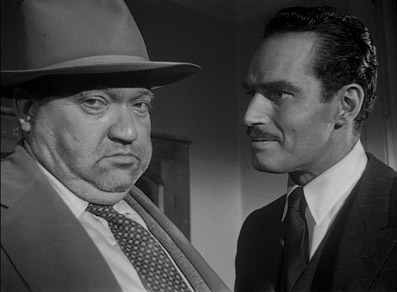
This Blu-ray release features five versions of the movie in three separate cuts. Four of the versions are two times two identical cuts except for top and bottom cropping to convert a 1.37:1 open matte frame to a widescreen 1.85:1 frame. The one I'm reviewing (and taking frame grabs from) is the 1.37:1, 1998 reconstruction based on instructions from Welles himself via an infamous fifty-eight page memo. The other cuts are the theatrical version (the one that's been in circulation the longest) and the preview version (the mid-edit cut preview screened which runs longer that both other versions and was at first excitedly thought to be Welles' own cut. Alas. This cut is only available in the 1.85:1 aspect ratio). The changes between the versions are interesting and varied but without the memo and the interpretation of Welles' instructions, I find it's not particularly constructive to 'review' the other versions as stand alone films. In my mind, all versions are now subordinate to the restored version.
I'm so familiar with the original studio release and like my response to the newly scrubbed up Blade Runner, my reactions to this restoration was a big "Oh wow!" I always admired Touch Of Evil for all the same reasons it became a famous 'flawed masterpiece' but there was always a nagging sense that the narrative got away from me a few times. Of course, it's not about the successful and satisfying resolution of the plot (although this happens in an almost throwaway, perfunctory manner) it's the characters' dilemmas that represent the whole style of the piece. But there were still narrative roots that tripped me up near the mighty oak, roots that should have been well buried. In the reconstruction, those roots are suitably banished. Welles' original intentions are honoured and any niggles I had about the actual narrative sense of the original theatrical cut have completely disappeared. Having seen it in all its versions four times in as many days (all versions have commentary tracks) I would say the reconstruction is the one that just works so well and hardly surprising given it's, as near-as-damn-it, Welles' director's cut (despite how many time the restoration's producer Rick Schmidlin refutes this – covering his own and ace editor Walter Murch's ass and that's admirable). Dead men not only tell no tales, they don't manage to rustle up director's cuts either.
The story is a relatively simple one but that simplicity stops there. It's the late 50s. A bomb is planted in a car at the US-Mexican border. A Mexican Drug Enforcement Officer, Vargas (Charlton Heston) is enjoying his honeymoon with new wife Susie (Janet Leigh) when the bomb goes off. That's the extraordinary three minute and twenty second opening crane shot – justly revered. I'll let the disc reveal the shot's information overload of minutiae of which there is a considerable amount. Heston gets involved with the investigation and with the local police chief, Hank Quinlan (Orson Welles). Both get wrapped up with the brother of the man Heston is investigating. Quinlan's morality is in serious question (he routinely frames whom he believes is guilty) and this behaviour goes against Vargas' moral yardstick while furthering Quinlan's reputation as a super-cop. Orchestrating the frightening framing and manipulation of Vargas' wife as a developing parallel story, Quinlan tries to discredit Vargas but the righteous Mexican fights back to expose Quinlan's corruption. Two giants go up against each other as the climax reaches almost Shakespearian proportions. I've been deliberately vague and broad because there are pleasures here to be mined but only as surprises. That's about as much of a spoiler-free account I can offer.

To digress just a tiny but relevant bit just in case there are sensitive souls out there that wouldn't support any work with a certain actor featured in it: As a person of a certain age, my two male role models (apart from my father of course) were Sean Connery and Charlton Heston. Their on screen heroics thrilled me and despite many opportunities to rewrite my own history, I've just folded in the complexities of people in the public eye into my memories as they are revealed to me. No human being is simply understood. In this media drenched world, a single word can trash someone's character forever from some points of view. No greater character assassination on one particular actor was ever done than what Michael Moore did to Charlton Heston in Bowling For Columbine. Now before this sounds like a Heston-apologista talking (I abhor Heston's later political stances) I have to say that the whole NRA connection was and is profoundly unpleasant but a little research and a few points on the commentaries (which I will come to) have made me re-appraise Heston. There's also a personal reason for the fact I cannot politically or otherwise dismiss him but as that's the paragraph's punch line, you'll just have to be patient. In point of fact, Heston was a liberal activist on the Civil Rights march in 1963 long before it was seen as fashionable for actors to actually express their political preferences. He was asked many times why he later deserted the left and his answer is suitably chilling as the left (as was) does not exist anymore within 'the system'. "I didn't change. The Democratic Party changed..." he said. It's hard to scrub the right wing varnish off the man but if the commentaries are to be believed, he was a gentleman, a professional and a fiercely loyal friend. Left or right, these are attributes to be applauded. And (finally) Charlton Heston was the very first actor who spoke the lines of my very first professional script. Add this to his performance in Touch Of Evil, and we are definitely in the "We are not worthy!" camp.
Back to the movie. Welles' stylistic touches and depth of creative thought edge out of the chiaroscuro if only with help from the commentaries. You will begin to appreciate Welles' achievements so much more if you avail yourself of the guiding and revealing words of the seven chosen experts, actors and restorers. As a fan of the film, my appreciation has now been raised several hundred percent from the information gleaned. So let's race to those treasured commentaries and continue the review via access to all that other information.
Presented both in 1.85:1 and 1.37:1, this is Touch Of Evil in every one of its many guises. Why both aspect ratios? The issue is dealt with in the excellent Booklet that accompanies the Blu-ray. Needless to say I went for the 1.37:1 as a favourite because the 1.85:1 is, of course, a crop, admittedly a planned crop by cameraman Russell Metty. Apparently Welles shot the film knowing it might be cropped for release – and even desiring it – but the original 35mm almost square area works gangbusters – such detail! Frankly, it's gorgeous in its monochrome glory, starkly black and white in a way only Welles could shoot and it's so clean. I could detect very few rips, tears and scratches. The movie looks good enough to eat.

The mono soundtrack, faithfully reproduced by a DTS Master 2.0 codec, is very clear if a little lacking in the low end and there are English only SDH subtitles as an option.
Bringing Evil To Life (20' 59")
A talking heads documentary on the inception and production of the film featuring both Charlton Heston and Janet Leigh and it's a delight. A lot of the stories are well known to Welles fans but it's nice to have them all under one roof so to speak. Also great to see Dennis Weaver still talking about a role that in any other movie of that time, would have been long forgotten or if not, the only memorable thing in that 'any other' movie. Director Peter Bogdanovich, a one time friend and advocate of Welles, provides all the background Wellesian detail.
Evil Lost And Found (17' 06")
Unless I blinked and missed it, this feature has no title actually contained within the film itself. Odd. This is the story of the film's reconstruction based on Orson Welles's reaction to the studio cut and his subsequent and infamous fifty-eight page memo. All those involved remember in great detail the aftermath of the shoot and the delivery of Welles' first cut. Cinematic history is often made by the smallest of incidents being granted huge weight. According to Rick Schmidlin, the producer of the restored version, a woman left the preview screening of the original 108 minute version and announced "That was the ugliest and dirtiest movie I've ever seen!" and hit a Universal Exec with her handbag. That Exec then went back and took ten minutes out of the cut, holing it under the waterline according to Welles. The director mistimed his trip south of the border after delivering his cut of the original Touch Of Evil. If he wasn't there to argue his case, the studio could ride rough shod over his wishes and it's not insignificant that Welles never directed a movie in America for the rest of his life.
Original Theatrical Trailer (2' 09")
The desperation of a studio seen through the over egging of a certain pudding. For all we can glean from the start of this trailer, the movie is about whether Janet Leigh is going to get gang raped or not. Appalling! It's fascinating to see how even the marketing of the film acknowledged Welles' own reputation. You get a sense they're almost apologizing for his uniqueness. That says more about the cookie cutter nature of Hollywood at that time. But it's a typically 50s garish example of the genre. Well worth what sometimes feels like a voyeuristic look.
Touch Of Evil – 1998 Reconstruction 1.85:1
Commentary by Rick Schmidlin, Producer of the Restoration
This is an absolute utter gem of a commentary. Why? Because Rick Schmidlin is one of us – a cinephile who got lucky, a movie nut, a geek who lucked into working as the restoration producer on an amazing film working with extraordinary people. To paraphrase him, "I went from being a movie geek to working on an Orson Welles movie with Marlene Dietrich!" Apparently Welles wanted the widescreen cut from the outset. This was an era when super-exec/agent Universal's Lew Wasserman could see the writing on the wall (or in this case the television set in the corner) and so wanted to emphasize the difference a cinema visit makes.
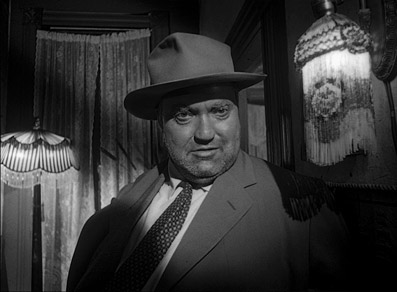
Because of the quality of the work being done, Schmidlin was initially downcast that a full restoration could not be achieved – this is until a studio exec saw the value of his work and gave an extra $40K for a digital restoration. It's because of this, the movie looks minted, new and improved – marvelous. Schmidlin talks about one of the original editors of TOE and how this wonderful man pulled out a box of late 50s correspondence and gave it to the restoration project. This turned out to be a goldmine of sorts – original memos from Welles, just a treasure trove of insight and creative power. One item moved restoration editor Walter Murch to tears outlining one of Welles' specific sound ideas – exactly the same one that Murch believed he had created for American Grafitti. To no one's astonishment, Welles had got there first.
It's hinted that Hitchcock was a big fan of Touch Of Evil and that The Night Man (played gloriously by Dennis Weaver) was an obvious forerunner of Norman Bates. That poor Janet Leigh and her choice of motels. When Welles delivered his first set of rushes (an extraordinarily complex 4 minute interior shot that effectively put the crew ahead of schedule) the executive reaction was "That's just Orson showing off..." Schmidlin doesn't skirt the Charlton Heston and politics issue either but having said that he adores the man and being able to call him 'Chuck'. There is some astonishment that the film is still known as being a 'B' movie (with that cast?) and the little known fact that this was Henry Mancini's first movie score (the IMDB doesn't bear that out but I'll go for it for now). This commentary is a goldmine of information but merely one of four goldmines...
Touch Of Evil – 1998 Reconstruction 1.37:1
Commentary Rick Schmidlin, stars, Charlton Heston and Janet Leigh
What a terrific opportunity for the cast to find out various aspects of the production that they were not privy to at the time. It seems the scapegoat on the shoot was the sound recordist that Welles tried to confound at every turn. There is a film industry trick that I found out about reading and re-reading Bob Balaban's diary on his time acting in Close Encounters of the Third Kind. To get through a day a scapegoat is created from within the crew and although it is an arbitrary choice, it gives the cast and crew a way to vent frustration (in private). Also, to my astonishment, there are CG fixes in the restored cut. No, no, we're not talking about the addition of a spaceship and alien hordes descending on the border town of Los Robles. Some of Welles suggestions asked for changes that may have not been available in the rushes. One of them included the idea that Quinlan's eye line should be different at the end of an early scene – so it was made so with CG. Astounding!
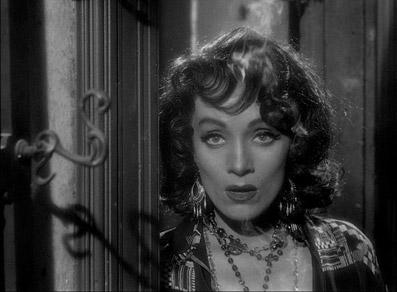
The whole commentary is chock full of wonderful production detail. Heston didn't even know the movie was very loosely based on the novel Badge Of Evil. It's fascinating to have the reshoots by the studio identified. It's also very tempting to be pretentiously blasé and say "Oh, of course Welles didn't direct that shot..." but that's not as easy as it looks because it's about what works for the story. Welles actually praised some of the new scenes for injecting more clarity. If you really want to see a jarring shot not in keeping with the director and camera person's intentions, look no further that Hitchcock's classic Vertigo and the restaurant scene. There's a shot of Kim Novak that is so bland, flat and so different to everything that came before and after that it's extraordinary it managed to stay in the movie. Both Heston and Leigh (then in their elder years let's say as they are now, alas, both gone) are charming but also lively and still showing great affection and respect for this small masterpiece. Schmidlin makes an excellent, if unsurprisingly overawed, moderator.
Touch Of Evil – 1958 Theatrical Cut 1.85:1
Commentary by F. X. Feeney
Critic F. X. Feeney waxes poetic about the first shot but also confirms what Slarek and I both agreed about – we all loved the Mancini score over the first shot. Of course we've all lived with that version for many years. Murch's complex overlapping of location sound in the restored version is also effective but that score... Feeney underlines the taboos that were being teased and broken in the film. It's difficult for a 2011 audience to appreciate just how daring this movie was in 1958. Feany says "Small wonder there's an explosion when these two kiss..." Of course Heston plays a Mexican with sometimes too much dark make up and the idea that a Mexican man and an American woman could be even seen together. My word.
Some of the detail that flew right by me is that the poster of 'Zita' that is horribly destroyed by acid meant for Heston is a reference to the character of Zita who is horribly destroyed by the bomb in the opening (she's the lady who complains about a ticking sound in the car). There are many instances of information overlap as there had to be but it's insignificant as each speaker comes at the information from a unique angle. Feeney reveals that some trusted source worked out that of the seven million listeners to Welles' infamous broadcast of War Of The Worlds, one million were affected by it and bought its premise.
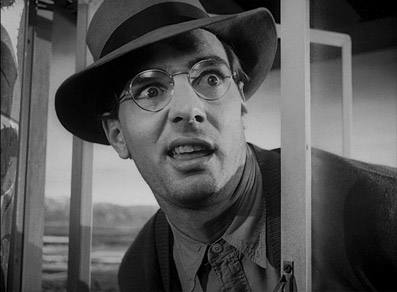
Feany also tackles the Heston/Politics issue and comes to the conclusion that if there was one thing Heston valued above all others it was freedom. So he went from being a liberal to a libertarian. I can't square that off with staunch right wing ideals but we'll let that one go too. He caps off his excellent contribution to the greatness of this film with, for a critic, a surprising announcement. He says that "Touch Of Evil is a deeper and wiser film than Citizen Kane..." Big words and there's a lot to be said in favour of that view (as there is a lot being said on this plethora of commentaries and we haven't even got to the Welles experts yet).
Touch Of Evil – 1958 Reconstruction 1.37:1
Commentary F. X. Feeney (same as the 1.85:1 Cut)
To be frank, I only listened to the first few lines in this commentary to confirm it is identical to the one that preceded it. If Feeney suddenly breaks off into a second different commentary ten minutes in then I'm afraid I would have missed that. We are thorough on this site but few of us have that much free time.
Touch Of Evil – 1998 Reconstruction 1.85:1
Commentary by James Naremore and Jonathan Rosenbaum (film scholar and film critic respectively)
These gentlemen are the Welles experts, Rosenbaum having been brought in by producer Schmidlin to keep the restoration effort as 'Wellesian' as it could be. As hoped, these two approach the film from another angle. They talk about the political context of the film and confirm that Touch Of Evil was Welles' least politically correct film. They also bring up issues that would never occur to me even after having seen the film many times. Just why would a man on his honeymoon bring his wife to the sparse, violence prone streets of Los Robles? The only thing to do here is get harassed by hoodlums. What a honeymoon.
It's revealed that the journeyman director Harry Keller shot the scenes deemed by the studio vital to make sense of the narrative. There are some appalling lapses in continuity between what was originally shot and shot after Welles' departure but they are only noticeable when they are pointed out. There's a line in the film pertaining to Quinlan leaving his walking stick at the murder scene, a line that is ripe for cinematic scholarly interpretation – "A cane that gets left behind..." Lovely. It's nice to see Mort Mills getting some recognition. He's Vargas' only friend in the film and another link to Psycho – he plays the cop with the sunglasses pulling Janet Leigh over.
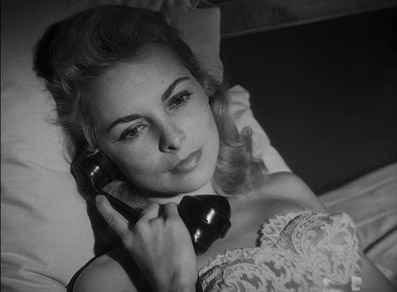
Dennis Weaver's performance also gets a nod, once described as a "spastic woodpecker" (it felt almost naughty just spelling the word but remember, the past is a different country). Tiny bits of detail continue to astound me. Once the restoration was complete, it was shown to Rosenbaum who immediately asked "Where's the punch?" – a sound effect of Quinlan roughing up his suspect while we're on Vargas in the bathroom. You get the distinct impression that these men really know their stuff. Oh, and Janet Leigh did half of this movie with a broken left arm!
The stand out scene inviting the Hayes Code's wrath (the US censor at that time) was the explicitly suggested gang rape scene of Janet Leigh in the motel room. It's all done with low angles and menacing stares but its power remains undiminished even though Leigh is visually manhandled just the once. The actress claims she performed this herself but even a Blu-ray's detailed picture didn't give me enough detail to confirm this. I suspect it was a stuntwoman. If you have a healing broken arm, you're not going to be flailing for your life as several 'delinquents' pick you up off a bed.
The scholars confirm that the studio cut with the reshooting and the re-editing was hard to follow (phew, it wasn't just me then). The movie was released with no press shows (in the industry, this is because the studio fear widespread negative reaction and have all but given up on the project) and little fanfare despite the A-list talent on display. It didn't do well (what a surprise) but it's heartening to see it receive this kind of attention fifty-eight years later. It's also nice to hear the two confirm the importance of editing. My favourite Welles quote ("...As for my style, for my vision of the cinema, editing is not simply one aspect; it's the aspect.") was referring to the editorial debacle that plagued this wonderful movie. I'll give writer/director Paul Schrader the last word. About Touch Of Evil, he said "It is the epitaph of film noir," and what a glorious epitaph.
Accompanying 56 Page Booklet
Oh, this is a great and rewarding trend in these digital days. Even though reviewers get the PDF versions, I must say the Booklet is a tremendous resource for further appreciation under one roof. Here we have articles and reviews on the film from luminaries such as François Truffaut and André Bazin and two pieces from Welles, an exhaustive interview and a curious piece decrying the larger cinema screens being rolled out to combat TV. There's a timeline charting the movie's changing fates and a discussion about the two aspect ratios conundrum. And it's lavishly illustrated including a shot of Welles at the time sans Quinlan make up. There's also a retrospective taken from a 1971 issue of Film Comment by Terry Comito. It's a terrific addition to the Masters Of Cinema canon.
Considering the importance and significance of Welles' memo upon which the restoration was based, it seems a little odd it's not included in the Extra Features as it was on the NTSC DVD of the release. Could this be because Rick Schmidlin is planning a book about the restoration using the memo as a spine? I'm not unduly upset at this as I will probably buy the book too...
Welles' last Hollywood directorial gasp and a classic noir is a terrific movie on all manner of levels. It's part cop thriller, part character examination and all evidence of a rare talent behind and in front of the camera. Touch Of Evil is Welles firing on all creative cylinders. Now you can see in HD exactly why the discerning Dr. Wilson from House has a poster of Touch Of Evil up on his wall. Highly recommended.
|